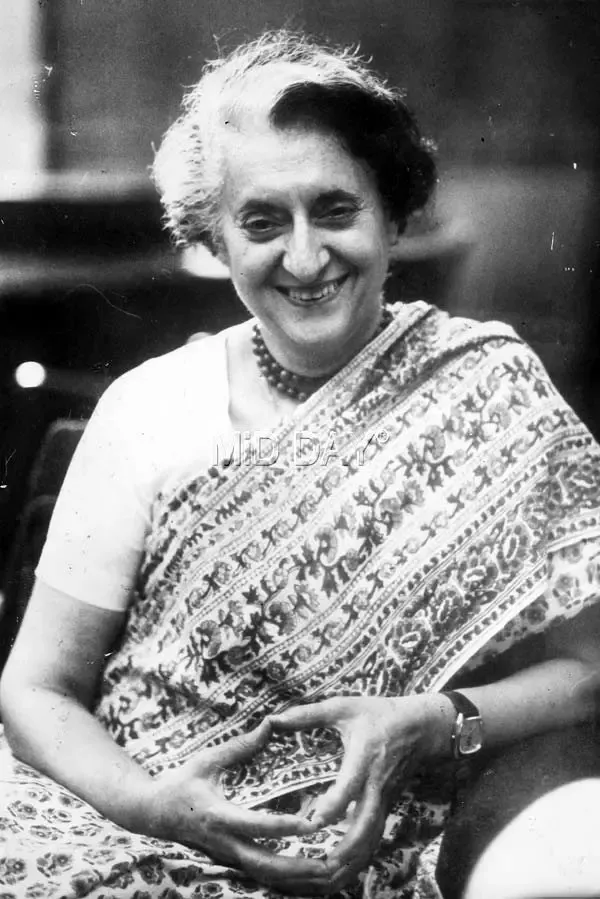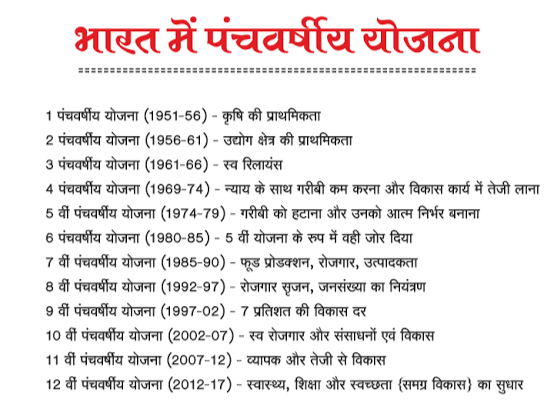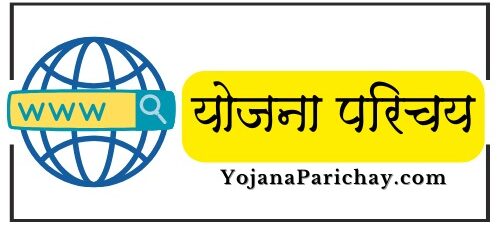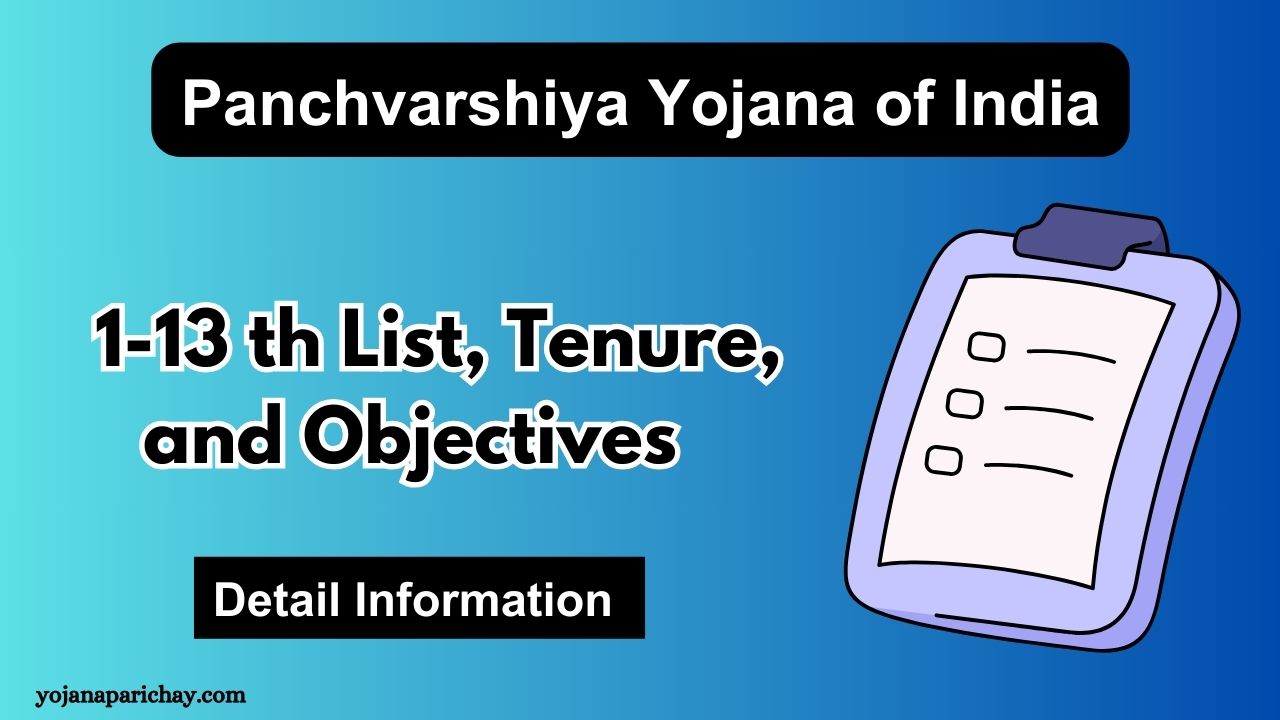Panchvarshiya Yojana of India – Hello friends, today in this article we are going to know complete information about panchvarshiya yojana. In this article you will know what is panchvarshiya yojana in marathi, what are its benefits, read the entire article to know complete information about panchvarshiya yojana.
Every five years the central government conducts the Panchvarshiya Yojana of India to promote the social and economic progress of the population. In India, the first Panchvarshiya Yojana of India was introduced in 1951 and the 12th Yojana was implemented in 2017. Every five-year plan that has existed since its inception has certain primary objectives, such as promoting development in the industrial and agricultural sectors, creating a dynamic economy and enabling people to become strong, independent and self-reliant as well as creating new employment opportunities.
What is Panchvarshiya Yojana of India ?
Panchvarshiya Yojana is a national scheme of India. These programs were earlier managed by the Planning Commission, but will now be taken over by the NITI Aayog. NITI Aayog was established on 1 January 2015. They are unable to take any decisions on behalf of the states. Will act as a council for advice. which will establish the norms going forward for the betterment of the population. The schemes provided many benefits and facilities to the people. The scheme has been largely effective in enabling the country’s population to become self-reliant.
Let us inform you that the 13th Panchvarshiya Yojana of India will bring new employment and agricultural development prospects in the country, as well as provide many facilities for utilization of human and material resources to increase production.
1 st Panchvarshiya Yojana of India : (1951-1956)
The country’s first Prime Minister Jawaharlal Nehru launched the country’s first five-year plan. On December 8, 1951, Nehruji made a presentation in Parliament. According to the terms of the first five-year plan, all the inhabitants of the country were expected to experience a wave of joy at independence. As everyone was concerned about the country’s grain shortage at the time, the program focused more on agricultural growth.

In addition, the government added the important objectives of construction of dams and irrigation, Bhakra Nangal Dam and Hira Kund Dam; The plan’s growth exceeded its 2.1% target by 3.6%. The scheme was most successful as it was launched after the country’s independence, which ushered in a new chapter in the nation’s history.
Functions and Objectives of the First Panchvarshiya Yojana
- Agricultural development was given priority to improve the economic condition of farmers in the country.
- Irrigation and dam work started.
- Once again, all the refugees were given houses.
- Extensive development schemes were launched to benefit the population of the country.
2nd Panchvarshiya Yojana of India : (1956-1961)
After the expiry of the previous Panchvarshiya Yojana, the government launched the second five-year plan, which prioritized industries. Its primary responsibility was to manufacture industrial goods from local produce. Steel plant mill towns like Bhilai, Durgapur and Rourkela were built under this initiative and hydropower was created.
Major objectives and tasks accomplished under the Second Panchvarshiya Yojana
- Priority is given to industrial product development.
- A plan was prepared to set up an industry.
- In 1957, the scholarship was established to assist students in their academic endeavors.
- Coal production increased greatly.
- Heavy projects and hydropower construction were sanctioned in cities with established steel mills.
Third Panchvarshiya Yojana of India : (1961-1966)
Another name of third Panchvarshiya Yojana is Gadgil Yojana. The primary objectives of the Third Plan were to make the people of the country self-reliant and to activate the economy. During the Third Panchvarshiya Yojana of India period, there was a war between China and India in 1962 and a war between India and Pakistan in 1965. As a result, the economic structure of the country suffered a major blow, making it impossible to meet the objectives of the plan.
However, many other projects were still ongoing, such as the development of agricultural projects, the construction of dams, and the establishment of schools for children living in rural areas. States were given powers over development related projects. Green revolution started during this plan. The government set a growth target of 5.6%, but only 2.84% growth was achieved.
Major objectives and tasks accomplished under the Third Five Year Plan
- Development of wheat and agriculture was encouraged.
- Schools were built to educate the youth living in remote areas.
- Work on dams and irrigation systems continued.
- Manufacturing of cement and chemical fertilizers.
- Punjab was the first province to introduce wheat production on a large scale.
Important information
After the expiry of the Third Panchvarshiya Yojana of India, no new five-year plan was prepared by the government from 1967-1969; It was called a Plan Holiday.
4th Panchvarshiya Yojana of India : (1969-1974)
In the fourth Panchvarshiya Yojana, Indira Gandhi became the first woman Prime Minister of India. After that, Indira Gandhi took over the reins of the Five Year Plan. In addition to nationalizing fourteen Indian banks, Indira Gandhi’s administration coined the slogan “remove poverty” in the 1971 elections. The Vice Chairman of Planning Commission DP Gadgil planned the scheme.

Since the beginning of the Green Revolution, work has been done for agricultural production. Its target was set by the government at 5.7%, but its growth was only 3.3%. This five-year plan failed.
Major objectives and tasks accomplished under the Fourth Panchvarshiya Yojana
- The highest objective of this plan was the definite economic development of the nation.
- ISRO was also created as a part of this concept.
- The plan called for the establishment of industries in underdeveloped areas, which guaranteed the growth of such areas.
- The government nationalized 14 Indian banks and established the Indian Food Security Scheme, the Public Distribution Scheme (PDS).
Fifth Panchvarshiya Yojana of India (1974-1979)
In the fifth Panchvarshiya Yojana of India, more emphasis has been placed on agricultural development. After that, the planning of the industrial building was considered as the second priority. Banks were established for rural areas.
The objectives of Panchvarshiya Yojana of India were to end poverty, create new employment and strengthen the country’s legal system. The newly elected Morarji Desai, the fourth Prime Minister of India and a member of the Janata Party, rejected the idea in 1978. Its growth was 4.9% against the target of 4.4%. This strategy works as intended.
Major objectives and tasks accomplished under the Fifth Panchvarshiya Yojana
- Grameen Banks were established on 2 October 1975.
- The primary objective of the scheme was to completely eradicate poverty.
- Social forestry was also started under this scheme.
- The mission of the Roadway SYSTEM was to build a national road.
- Road widening information was given in the background of increasing traffic.
Important details
Let us tell you a very important story: Indira Gandhi’s government lasted only four years due to national re-election. Then the newly elected leader of the Janata Party, Morarji Desai, was announced as the new Prime Minister. After the abolition of these schemes, it is important to note that indigenous economist Gunnar Myrdal formulated the Rolling Policy, which is an annual policy for the development of underdeveloped areas.Morarji Desai approved this strategy, which was credited to Prof. D.T. Goes to Lakdawala.
Sixth Panchvarshiya Yojana of India :(1980-1985)
The primary objectives of the sixth Panchvarshiya Yojana of India were economic growth and poverty alleviation of the country. During this plan, Indira Gandhi once again became the prime minister. There were two drafts of this proposal.
The Janata Party first launched the “Nirant Yojana” from 1978 to 1983. However, it was abolished and reinstated for the Sixth Five Year Plan formulated by the Indira Gandhi administration in 1980. This strategy proved effective. Its growth exceeded the 5.7% target, which was established.
Major objectives and tasks accomplished under the Sixth Panchvarshiya Yojana
- NABARD Bank was established as a part of this scheme.
- Emphasis was placed on providing jobs to the residents.
- Its main objectives were poverty alleviation and economic growth.
- At the same time the program began, the nation began to liberalize its economy.
7th Panchvarshiya Yojana of India : (1985-1990)
The primary objectives of the 7th Panchvarshiya Yojana of India were to increase economic productivity, boost food production, provide new employment opportunities to the country’s residents, provide social services to the masses and promote regional development.

Its growth exceeded the 5.0% target by 6.01%. The Indira Gandhi administration implemented the following three schemes under the Seventh Five Year Plan.
- Indira Awas Yojana (1985-1986)
- Jawahar Employment Scheme (1989)
- Nehru Employment Scheme (1989)
Major objectives and tasks accomplished under 7th Panchvarshiya Yojana
- New job opportunities created.
- The proposal included the tagline “Food, Work and Production”.
- Worked for the development of the residents.
- Many schemes were developed to guarantee that social services are provided to the people.
- Efforts to stimulate the economy continued.
- Highlighting recent initiatives and policies.
Important details
Two annual schemes were adopted instead of the eighth Panchvarshiya Yojana of India, which was scheduled to start on time but was delayed due to the instability of the country’s central government. These programs were implemented in 1990-1991 and 1991-1992. The Small Industries Development Bank of India, or SIDBI, was established in 1990 and in 1991 plans for financial reforms were announced. After the completion of these plans, the Eighth Five Year Plan was started.
8th Panchvarshiya Yojana of India : 1992-1997
The primary objective of the 8th Panchvarshiya Yojana was to develop the country in relation to its citizens. Human resource-related functions include creating educational facilities, developing educational programs, creating job opportunities, and formulating new social development strategies.
Pradhan Mantri Yojana was also launched on this occasion. The government prioritized energy expenditure by 26.6%, indicating that the energy sector has also received attention. The plan was also successful with a growth of 6.8% and a target of 5.6%. Narasimha Rao himself endorsed the plan, which included economic policies. Financial policies such as:
- Privatization
- liberalization
- globalization
Major objectives and tasks accomplished under the Eighth Panchvarshiya Yojana
- Education is given priority.
- Human development was its primary objective.
- Try to increase the population
- eradicating illiteracy in the age group 15-35 and establishing institutions for national development.
- Promotion of transport, energy and irrigation under the scheme
- Formulated policies to strengthen Municipalities, Panchayat Raj and Human Resource Foundation.
9th Panchvarshiya Yojana of India : (1997-2002)
Under the ninth Panchvarshiya Yojana of India , each task was required to be completed equally for the economic progress of the country. It was enacted on the occasion of India’s 50th anniversary. Formulated a fifteen year planning strategy for development.
But despite all the economic growth, this strategy did not succeed. However, the objectives of other schemes—such as poverty alleviation, achieving domestic resource self-sufficiency, creating new employment opportunities, promoting human development, etc.
Apart from this, all the ongoing projects included development of rural communities, agriculture sector, building for education, clean drinking water etc. Its growth was 5.5%, while its target was set at 6.5%. Many employment schemes were prepared under this initiative. Following are the employment schemes:-
- Jawahar Village Prosperity Scheme
- Suvarna Jayanti Sehri Employment Scheme
- Swarna Jayanti Village Self Employment Scheme
- Pradhan Mantri Gramodaya Yojana
Major objectives and tasks accomplished under the Ninth Panchvarshiya Yojana of India
- The program aims to end poverty, make the country self-sufficient in domestic resources and create new employment opportunities.
- Economic development of the country was given first priority.
- Appropriate and accurate utilization of basic institutions, more emphasis on rural areas
Tenth Panchvarshiya Yojana of India : (2002-2007)
The main objective of the 10th Panchvarshiya Yojana was to eradicate poverty across the country to strengthen the nation. It was a significant step towards strengthening the economic position of the country by doubling the per capita income and eradicating unemployment by providing new opportunities for the population. In 2003, children were admitted to all schools. Between 2001 and 2011, the country’s population declined by 16.2%. Its growth was 7.7% against the target of 8%.
Major objectives and tasks accomplished under the 10th Panchvarshiya Yojana of India
- In less developed areas, people were provided employment, which enabled them to become independent.
- In 2007, primary education was at the top.
- The five-year plans up to this point mostly focused on agricultural expansion and high energy costs.
11th Panchvarshiya Yojana of India : (2007-2012)
The sole objective of the eleventh Panchvarshiya Yojana was to develop comprehensively, with the primary objective of accelerating growth as much as possible. Manmohan Singh officiated as the Prime Minister of India in this event.
This strategy was planned by Rangarajan. As part of the plan, it was decided to clean all rivers and waterways in 2012. The total budget of the scheme was Rs.71731.98. It grew by 7.9% against the target of 8.1%. Three new initiatives were introduced throughout the scheme to help the population. Following are the plans.
- Pradhan Mantri Adarsh Gram Yojana
- Aam Aadmi Bima Yojana
- Rajiv Residential Scheme
Major objectives and tasks accomplished under the Eleventh Panchvarshiya Yojana of India
- Throughout the year, a growth target of 9% was established.
- A 4% growth target was established for the agriculture sector and a 9-11% target was set for industry and services.
- The theme of the eleventh Panchvarshiya Yojana is “Faster and More Inclusive Growth”.
- The objective was to develop energy and provide electricity to rural areas.
- Another goal was to provide safe drinking water to everyone.
12 th Panchvarshiya Yojana of India : (2012-2017)
The objective of the Twelfth Five Year Plan was to provide infrastructure for rural and urban development, including energy, industry, agriculture, communication and transport. The program emphasized social service, education, industry, agriculture and energy. A 10% annual target for economic expansion was established. The economic growth target for the Eleventh Five Year Plan was reduced from 9% to 8.1%.
Major objectives and tasks accomplished under the Twelfth Panchvarshiya Yojana of India
- Electrification of all rural areas by 2017.
- To provide safe drinking water to all residents for their health.
- To create awareness about financial services among all
- To get rid of discrimination against women and girls, Scheduled Castes and Tribes, Backward Classes and other groups.
- This concluded the Five Year Plan; Going forward, only five-year protection schemes will be applicable.
Important information:
The Planning Commission, which oversees the implementation of the Panchvarshiya Yojana, was disbanded by the Modi administration in 2014. On the contrary, Niti Aayog was established in 2015.
Thirteenth Panchvarshiya Yojana of India
Let us first inform you that the five-year plans are no longer available. The 13th Five Year Plan will not be created.. NITI Aayog has published a draft action plan in response to the Twelfth Five Year Plan. It has resulted in a 15-year vision paper. which will provide a three-year action plan along with a seven-year strategy.
It explains what programs and services the government will offer for the benefit of the country’s residents. It will guide the national growth of the government till 2035.
Historical details and important information about the Panchvarshiya Yojana
- Let us share this information with you: In 1928, Soviet leader Joseph Stalin, an Englishman, drew up the country’s first five-year plan.
- In India, the Five Year Plan was initially implemented when the Prime Minister was in office.
- On July 8, 1951, the first Prime Minister of the country, Pandit Jawaharlal Nehru, presented the first Five Year Plan in Parliament.
- While giving important decisions, Jawaharlal Nehru ji kept in mind the interest of economic prosperity of the people.
- As food shortages, dams and irrigation were a major concern for the population at that time, the project gave special attention to the agricultural sector.
- The First Five Year Plan was important because it allowed for the growth of the nation after its independence brought a wave of happiness to all its citizens.
Features of Panchvarshiya Yojana of India
- Prime Minister Jawaharlal Nehru initiated the scheme, which he unveiled on 8 July 1951.
- The Planning Commission was established on 15 March 1950 for the implementation of these Five Year Plans.
- The program for national development is implemented for five years, after which the government decides on new initiatives for the next five years.
- The primary objectives of the program are to end poverty in the country, provide job opportunities, increase the level of independence of everyone and increase economic growth.
- Changing and improving the lifestyle of the national population while simultaneously addressing the country’s economic situation.
- Thirteen implementations of the five-year plan have been implemented across the country.
- Thirteenth Five Year Plan will not be prepared. NITI Aayog has published a draft action plan in response to the Twelfth Five Year Plan. It has resulted in a 15-year vision paper. Which has a seven year plan.
NITI Aayog 15 Year Perspective
The administration hopes to achieve three goals: improved economic conditions, a safer and cleaner nation, and eradication of corruption. All rural and underdeveloped areas will get electricity to their homes. Everything will be crystal clear and spotless. Keeping this in mind, the administration has prepared this strategy.
- Fifteen Year Vision Document: 2017-18 to 2031-32
- Seven Year Strategy: 2017-18 to 2023-24
- Three Year Action Plan: 2017-18 to 2019-20
- Under this scheme, the residents of the country will have access to various facilities in their homes, including: Construction of toilets in the homes of people without toilets.
- Every household will have access to LPG hookup and all poor communities in the state will get electricity.
- The government wants to ensure that more than half of the country’s population can afford essential items like air conditioners and two-wheelers, depending on their financial capacity.
- Under the three-year action agenda, plans will be developed for the growth of industry, services and agriculture.
- Plans have also been made for the growth of the sector, focusing on education, clean environment and strengthening of water supply, among other things.
- All persons should have timely access to health facilities. His goal will be:
- Building heavy industries and improving all social sectors of the country.
- Better expansion of roads, railways, airplanes and sea channels is essential for the economic development of the country.
- Allow us to inform you that increasing the country’s GDP is one of the main objectives of the government. Let us inform you that India’s GDP has increased by Rs 91 lakh crore in the last 15 years.
- This policy is expected to increase India’s GDP from Rs 332 lakh crore to Rs 469 crore in the next 15 years. The GDP of the country is 137 lakh crore rupees.
- Children from lower socio-economic strata and disadvantaged students will receive differentiated instruction through remedial classrooms under this program. All media, including books and schools, will eventually be closed.
- All students will now have internet access for online education.
- Students will get a wide range of resources including facilities, services and support to prepare for civil services exams as well as state and federal level exams and other competitions. As a result of which the nation will progress and experience economic development in the near future.

Which Panchvarshiya Defense Plan is Thirteenth?
Panchvarshiya Yojana till now includes defense planning. Which started in 1964-1969. On the other hand, the Defense Scheme was launched in the third year (1962) of the Five Year Plan. We assure you that the discontinuation of the Five Year Plan will not affect it in the slightest. Hence, the five-year protection policy will continue. The Finance Minister is briefed on this strategy, as this information is required to assist the armed forces.
We would like to inform you that the 15-year vision paper will cover military and internal security. Which is no longer included in five year plans. The NITI Aayog will now deal with it.
Friends, how did you feel about the information given about Panchvarshiya Yojana of India? You can tell us by commenting. If you have any suggestions regarding this article, you can tell us by commenting. Friends, keep visiting our website https://yojanaparichay.com/ to get updated information related to such government schemes.
FAQ
What is Panchvarshiya Yojana of India?
The Planning Commission and NITI Aayog formulated and implemented the Five Year Plan, which served as the foundation for economic planning in India.
How many Panchvarshiya Yojana of India were created in the country?
The nation prepared a total of twelve Five Year Plans. NITI Aayog has released a draft action plan for the post 12th Five Year Plan. It resulted in a 15-year long-term vision paper.
Who started India’s first Panchvarshiya Yojana and when was it started?
The first Prime Minister of the country, Jawaharlal Nehru, formulated the country’s first five-year plan in 1951.
Which is the most successful Panchvarshiya Yojana of India ?
We inform you that the most successful Five Year Plan of the country is the Eleventh, which ran from 1st April 2007 to 31st March 2012.

